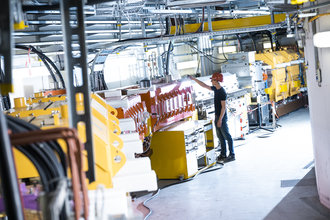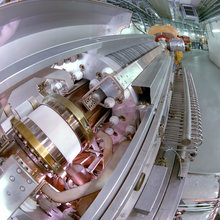Ring accelerator SIS18—the record holder
Ions coming from the linear accelerator UNILAC are injected into the ring accelerator SIS18 (Schwerionensynchrotron 18). Here they can be accelerated to even higher speed. They circulate in the ring and pass the so-called acceleration structures. Their high voltage accelerates them on every circulation. Magnets keep the ions on their circular path. Once they have reached the desired speed, they are transfered to the experiments to hit a material sample, or directed into the experimental storage ring ESR for storage and further analysis.
- 216 meters: The SIS18 has a circumference of 216 meters.
- 92 elements: The SIS18 can accelerate ions of all natural chemical elements of the periodic table—starting from the light hydrogen up to the heavy uranium.
- 270,000 kilometers per second: Ions coming from the linear accelerator UNILAC can be accelerated to up to 90 percent speed of light (270,000 km/s) with the SIS18.
- 80,000 volts: Ions in the SIS18 are accelerated by a voltage of 80,000 volts in the accelerator structures during every circulation.
- 416,000 circulations: The ions are accelerated in one second and cover a distance of 90,000 kilometers, that corresponds to 416,000 circulations in the ring.
- 32 billion particles: At no other accelerator as much medium-charged uranium ions can be accelerated as at the SIS18.
- one billionth Pascal: An ultra-high vacuum is a prerequisite for the acceleration. So ions almost never collide with particles in the air.
- Four experiments: With the beam coming from the SIS18 up to four experiments can be supplied parallely—from biophysics via exotic matter in planets and neutron stars up to the production of rare nuclei that are formed in supernovae.














